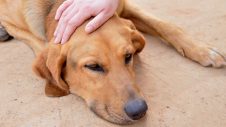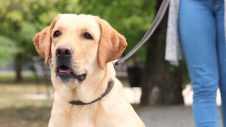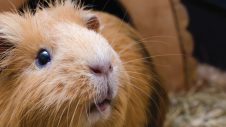We are all used to viewing pets as family members, but what happens when another little family member joins your pack? Having a baby is life changing for most parents, but what some fail to consider is that it is also a life changing experience for their pets too. It is important to prepare your furry friends for the arrival of your new little one to ensure that when they do come home, it is a stress free and calm process for everyone.
What to do before your baby arrives
The best way to help your pet adjust to your baby’s arrival is through training and forward planning. A good example of this is taking your dog for walks with your empty pram. It may feel strange, but this way they get used to the presence of the pram and the different ways they may need to walk to accommodate it. This can include their pace or position during the walk (e.g. instead of walking in front of you they now walk adjacent to you or the pram).
Ensuring your dog can follow basic commands like sit, stay and come are also important when preparing for your baby’s arrival. Your dog needs to be able to listen to and obey commands, even if they may not understand why you are asking this of them. Behaviour like jumping or lead pulling should be addressed quickly through training or puppy preschool to ensure your dog does not get over-excited when they see the new baby for the first time.
Creating barriers so your pet understands boundaries is also important. Dividing areas with baby proof gates can help stop your pet from entering spaces you don’t want them to, but also ensures not all the changes happen at once. Other changes can include transitioning your pet to sleeping in a different room or outside if they traditionally sleep with you in bed so that you can create the necessary separation you need between your child and pet.
Providing privacy or safe spaces for your pets is also important, so that if they get overwhelmed by touches, sounds or unwanted attention, they are able to remove themselves to a place they feel safe. For cats this may be on top of a cupboard and for dogs it may be their crate.
Desensitising your pet before the baby arrives is another way to ensure a calm transition. Babies bring with them an array of noises and new smells, so finding ways to acclimate your dog to this before the baby is there can help. From playing the sounds of babies crying in the background for your dog to get familiar with, to letting them into the nursery to smell nappies and wipes, it can all help the process become more gradual for them.
Bringing your pet to your local Greencross Vet is also a good preparation step. Not only can you ensure they are healthy by making sure they are up to date on their worming and vaccination treatments, you can also get their nails trimmed to reduce accidental scratches.
Bringing your baby home
Despite your efforts, bringing your baby home will still come as a shock to your pet, but we have a few tips on how to make it a positive experience.
If you have your baby in the hospital, send someone home with one of their blankets so your dog can familiarise themselves with your new arrivals scent.
It’s also important to make time for your pet when you get home. They likely will have missed you while you’re away, so ensure you greet them when you return home without the baby. Once they have gotten over their initial excitement of seeing you again, they will be calmer.
It’s important to reward your pet for obedient, relaxed behaviour in the presence of your baby. Never leave a baby and pet together unsupervised.
Cats can become quite scared and may retreat under the bed in the hope everything will return to normal. Let them come out in their own time and reassure them with lots of affection.
Once your baby is on the move, it suddenly becomes a lot harder. Always supervise when children and pets are together. Children love to chase and pull tails but it’s important to teach them from an early age that your pet isn’t a toy.
Preventing dog bites
Unfortunately, dog attacks occur far too frequently in Australia, with many victims requiring hospital treatment and in some more serious cases, reconstructive surgery. Children are particularly vulnerable to these attacks due to their small stature, however there are a few rules that if followed may help to minimise the risk of being bitten or struck down by a dog in the family home, friend’s house or at the park.
- Always ask the owner for permission before you pat a dog. Even the happiest dog can bite a stranger.
- Always allow the dog to come to you, do not move towards the dog. Never pat a dog on the top of the head or with an open palm as this appears threatening to a dog. Instead, offer your hand as a fist for them to sniff before tickling under the chin.
- Never approach a dog eating or chewing a bone, as they become protective of their food.
- Never wake a sleeping dog as this may frighten them and they may bite.
- Don’t play chasing games with a dog as children’s squeals can get the dog excited and they can accidentally knock them over.
- Always supervise your children with dogs as they often think of dogs as toys, picking them up, pulling tails and ears.
- Choose your dog carefully, making sure the breed and temperament fits in with your lifestyle, accommodation and how much time you can spend with it.
- Train your dog to obey basic commands such as sit, stay, drop and come.
- Talk to your vet if your dog shows any signs of aggression. These problems can often be stopped if managed early.
It is important to never leave a baby or child alone with a dog. Always supervise interactions to ensure safety for all.
Visit your local Greencross Vets to ensure your dog is up to date on all their vaccinations or to book them into our puppy preschool.

 Greencross Vets
Greencross Vets 











